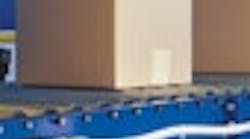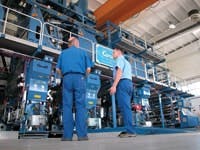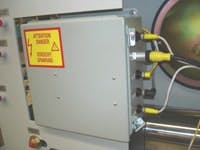Jim Montague is the executive editor for Control. Email him at [email protected].
Get it on the shelf, now. Sorry, I meant yesterday.
These typical retailer demands are why consumer goods manufacturers constantly seek new ways to streamline their processes, reduce time-to-market, and improve the quality and cost-effectiveness of their products. Can Lines Engineering builds and installs the material handling systems that help them do it, and so it too must continuously improve its own products and services.
Established in 1960, Can Lines designs, develops, and integrates packaging lines and conveying systems, mostly for users in the food and beverage industries. Most of its lines are custom-engineered and tailored to fit each customer's individual spacing and functional specifications. Located in Downey, Calif., the firm has engineering facilities in Greenville, Wis., and a manufacturing plant in Los Angeles.
The equipment that Can Lines fabricates and assembles includes can, bottle, case and pallet conveyor systems, palletizers and depalletizers, operator control platforms, and line-control integration systems. The company started out building its equipment and mechanical systems, and initially relied on other firms to design and install these material handling systems into specific applications, but gradually took over those tasks as the years progressed.
There are some stark differences between the old and new ways of designing, implementing, and distributing power for material handing systems and industrial networks. Here are some of their primary characteristics, according to Brian Wedin at Can Lines Engineering:
OLD WAY
- Plop conveyor hardware down on plant floor
- Set up panel
- Run conduit
- Determine wiring sizes, number, colors, and connections
- Pull and wire point A to point B, etc.
- Terminate both ends and add connections
- Test components and network
- Reinvent wheel on each new project
NEW WAY
- Think more about network ahead of time
- Define cable lengths, connections, required loads, pathways before installation
- Install modular components
- Reuse standardized methods on each new project
Today, its services consist of packaging line audits, material handling and packaging system design, equipment installation, construction and project management. The company's clients include many globally recognized companies such as Anheuser-Busch, Miller Brewing, Coors, Campbell Soup, Coca-Cola, Con Agra Foods, Del Monte, Frito-Lay, General Mills, Nestle, Pepsi-Cola, Pillsbury and Unilever.
Streamlining by Standardizing
To help these clients save time, implementation, and maintenance costs, Brian Wedin, Can Lines' lead electrical engineer, says his company recently sought new ways to streamline assembly, installation, and commissioning of its tailor-made systems. Can Lines also was seeking to standardize some of its parts, power, and network assembly process to save more time.
Because each plant's processing and/or packaging configuration is somewhat unique, Can Lines' installation team often found itself reinventing the wheel with every installation. Assembling, installing, and hardwiring smaller projects could take days, and larger projects could take weeks. This was due to the difficulty of working around obstacles when routing conduit and electrical wiring for powering a conveyor' and its related systems from a main power source.
"Installing the same 50 drives takes time, but installing 50 different drives takes more time, especially when there are different plant circumstances, platforms, and connections," says Wedin. "In many cases, the challenge was determining on-site how best to power the conveyor system without incurring excessive professional electrical time and labor costs. Our goal was to find a solution that would allow us to standardize machine power distribution in a way that would facilitate faster, easier, plug-and-play installation."
Historically, most conveyors were powered from one or a few centrally located panels, which then sent wiring and conduit into the field. However, many material handling systems now use drives that are mounted on the conveyors. For example, Can Lines uses Allen-Bradley Armor Start drives. "It's logical that connecting cable is easier than bending pipe and pulling cable, but having an electrical contractor run shielded cable to each device costs a lot, too. So, we also needed to reduce the complexity of the work being done. Usually, installing a couple hundred drives means you're putting in a couple hundred conveyor sections, as well as all the fillers, labelers, and packers in between."
Moving to Modular
While researching installation streamlining and component standardization, Can Lines found several solutions that could achieve sensor and device connectivity and communications. Though there weren't many modular, pre-wired solutions for cabling machinery requiring 480 V power, one of Can Lines' local vendors recommended BradPower, a modular power distribution system from Woodhead Industries, a division of Molex. The vendor said a major automotive OEM had installed a BradPower connection system in its automotive material assembly equipment. "Once we heard that, we knew it had to be a robust, reliable product," says Wedin. "In high-volume automotive manufacturing, production downtime just isn't an option because of the costs of delaying or halting the assembly line."
Modular wiring for machines and material handling systems began to emerge in 2002, after the National Fire Protection Association updated its NFPA-79 electrical standard, which governs electrical wiring used to power industrial equipment. These changes opened the door to development of a more flexible and cost-effective alternative to hardwiring for power distribution to factory-floor machinery systems. The new code allows use of code-compliant, factory-applied connectors, which are over-molded onto cables to provide up to 30 A feeder and 15 A branch power distribution circuits up to 600 Vac/Vdc.
As a result, Woodhead developed and launched modular, quick-connect, motor-control, and power-distribution systems for use on industrial machinery. The BradPower connection system consists of code-compliant electrical components, including trunk-feeder and drop-branch cordsets and connectors, receptacles, tees and reducers, locking clips, and a disconnect switch. Its dual-rated STOOW and TC/Open Wiring-rated, quick-connect cordsets allow a trunk/feeder line to be installed in a daisy-chain configuration along the material handling system's structure, with access points for power to be dropped to field devices such as motors, lights and heaters.
Woodhead reports its modular system gives users a standardized motor-control and power-distribution infrastructure that's robust, scalable, and easy-to-install without needing specialized tools and labor associated with traditional conduit or raceway cabling installations. It adds that using modular systems in industrial machine applications typically results in faster system assembly and commissioning, reduced installation costs, and greater efficiency of routine maintenance and repairs. Pre-wired systems also are easier to disassemble and reconfigure if needed in the future. Since their inception, quick-connect machine wiring systems have been used successfully in a host of material handling system applications, including conveying, sorting, automated storage and retrieval, parcel distribution, overhead transport, packaging, shrinkwrapping and palletizing.
Plugging and Playing
Can Lines recently helped Coors implement the packaging lines at its famous, new plant in Elkton, Va. These lines typically run at 1,200 bottles or 2,000 cans per minute. Using BradPower modular, standardized components, Wedin reports that Can Lines eliminated much traditional, third-party electrical work, and had its own mechanics install and connect the power and networking for these lines. The project's sensor and communications network uses DeviceNet, EtherNet/IP and Profibus protocols, and Turck's 24 Vdc and 12 Vac interconnect cabling.
"This was a much less expensive and faster installation. Modular power really allows more plug, play, and away you go," says Wedin. "There are a lot fewer tedious tasks, but you do have to think more about how you're going to design your network before you get there, or it definitely won't be so easy once you arrive. We have to better visualize the layout ahead of time, and make sure to ask clients about obstacles that might be in the way that they haven't told us about yet."
In the past, designing a non-modular, customized system was initially easier. "We did everything from scratch each time," explains Wedin. "Now, with standardized components, we always try to fine tune what we did before, but we have precedents and a base to work from. Once our mechanics learn the cable types and numbers of points and links needed in a given situation, then doing it soon becomes second nature, and we speed up installation with each project. Modular components also reduce what we need to connect, test and verify in the field."
In one of its first modular power projects, Can Lines was assigned to design and install a packaging system to work in tandem with a client's paper towel converting line in 2003. Though its customer was one of the world's largest consumer goods suppliers, Can Lines team decided to deploy BradPower's soft-wiring system in this complex, large-scale installation after seeing several demonstrations. This automated converting line begins with massive, two-ton rolls of tissue, which then go through slitters and rewinders, and are eventually narrowed to individual rolls of paper towels. This is where Can Lines' system kicks in, packaging the rolls and bundling multiples for conveying to the warehouse.
Wedin says a traditional hardwired installation for this packaging system would have taken up to four weeks from the time the components arrived at the plant until the system was assembled and ready to run. With the new connection system, CanLines could quickly develop the drawings, pick the components, soft-wire the chassis of each part, and code the parts onto a detailed installation plan. As a result, on-site assembly and installation time was reduced by 75%, according to Woodhead.
"It was like putting together the pieces of a puzzle with a complete blueprint of where every piece went," says Wedin. "At the plant, the electrical contractor only had to bring in the main power source. To bring power from the source to the pre-wired machinery was extremely easy — almost like hooking up a garden hose — which allowed that portion of the work to be performed very quickly by our regular installation team. Besides dramatically reducing installation time, I'd estimate that we saved our customer tens of thousands of dollars in electrical and operations costs."
Wedin credits Woodhead for the technical support provided by its industrial automation and BradPower experts. "This help was invaluable because the technology was new to us and, as with most projects, we were on an extremely tight delivery and installation schedule. Woodhead assisted in looking at the entire system and guided us to incorporate the BradPower components in the most efficient and cost-effective way possible," he adds.
As a result of the cost-saving and labor-reducing results experienced in this complex installation, Can Lines established BradPower's modular power distribution system as standard for all of its new material handling system design and engineering. "Since that initial project in 2003, we've continued to implement BradPower in every large-scale project. In fact, it has become a definite competitive advantage for Can Lines and for our customers," says Wedin.







